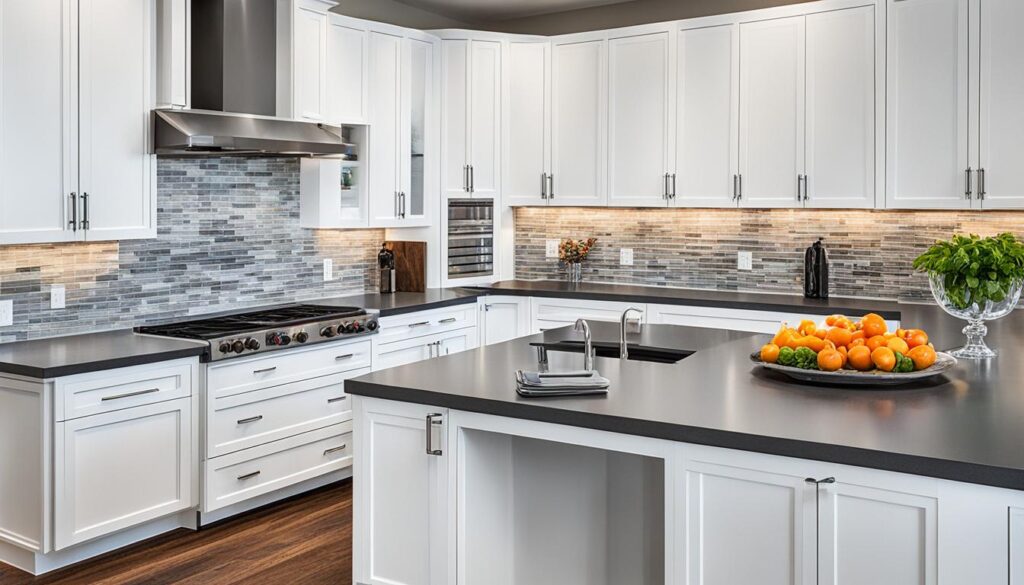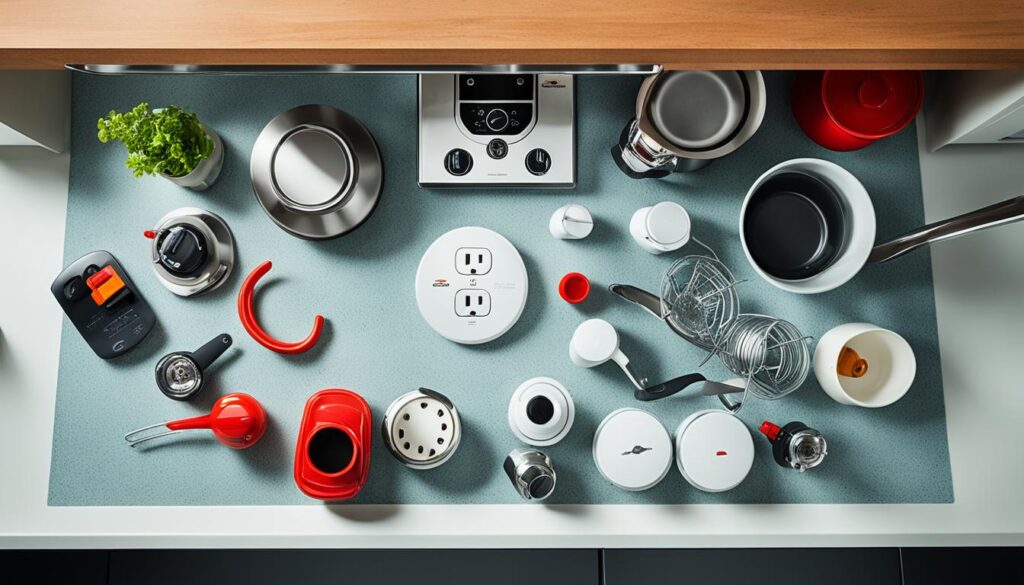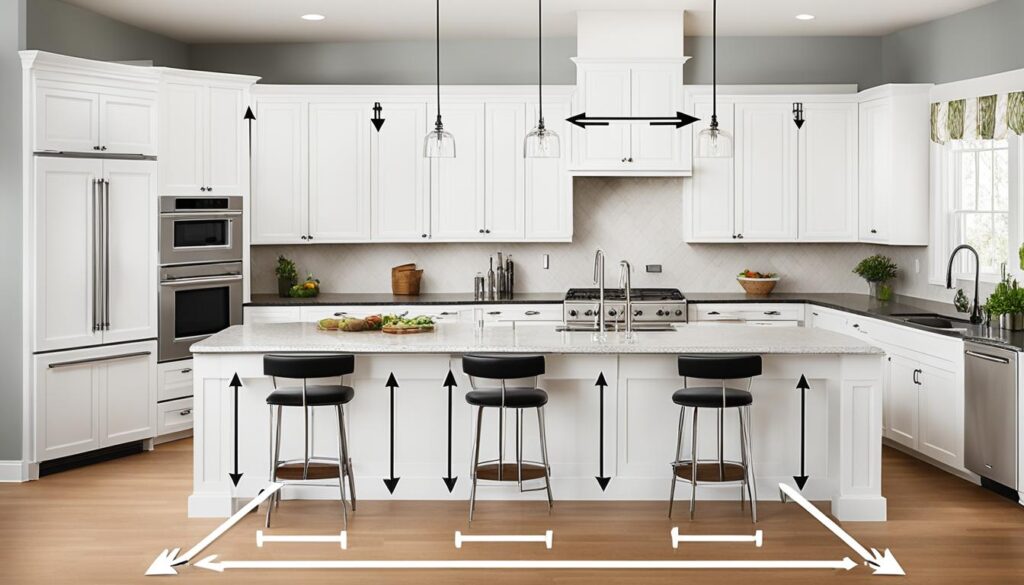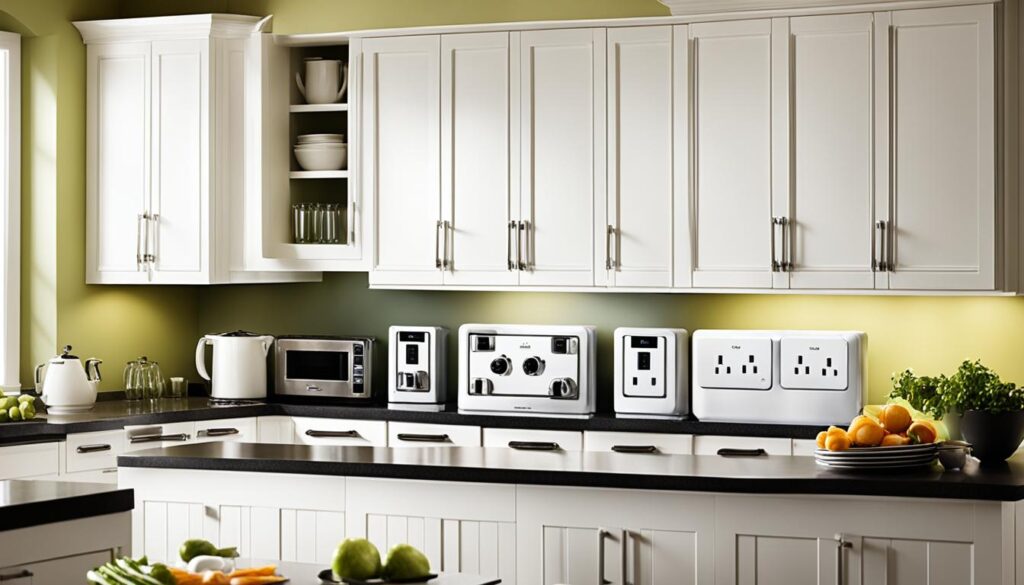When designing a kitchen, it’s essential to give careful thought to the placement and height of electrical outlets. Properly positioned outlets ensure safety and convenience in your kitchen. In this guide, I will provide you with the guidelines for determining the optimal kitchen electrical outlet height, so you can create a functional and efficient cooking space.
Good electrical outlet placement in your kitchen is crucial for easy access to power sources when using appliances or charging devices. By following the recommended standard height for kitchen outlets, you can maximize safety and convenience in your kitchen.
Key Takeaways:
- Properly placed electrical outlets are essential for safety and convenience in the kitchen.
- Adhering to the optimal kitchen electrical outlet height ensures efficient use of power sources.
- Consider the number of outlets needed based on the size of your kitchen and the appliances you plan to use.
- Always consult with a qualified electrician for proper installation and adherence to safety regulations.
- By planning the placement of electrical outlets in your kitchen strategically, you can enhance both convenience and functionality.
Planning Electrical Outlet Placement in the Kitchen
Before installing electrical outlets in your kitchen, it is important to plan their placement carefully. Proper planning ensures convenience, functionality, and adherence to safety guidelines. Here are some guidelines to help you plan the placement of electrical outlets in your kitchen:
1. Consider the kitchen layout:
Assess your kitchen layout and identify the areas where electrical outlets are required. Common areas for outlets include countertops, kitchen islands, and backsplashes. Ensure that outlets are easily accessible and conveniently located near appliances and work areas.
2. Follow kitchen outlet placement guidelines:
Refer to kitchen outlet placement guidelines to determine the optimal height and spacing between outlets. This ensures safety and compliance with electrical regulations. Typically, outlets are positioned 18-24 inches above the countertop surface and spaced no more than 4 feet apart.
3. Consider installing electrical outlets in kitchen cabinets:
Installing electrical outlets inside kitchen cabinets can enhance the functionality and aesthetic appeal of your kitchen. This allows for discreet charging of devices and eliminates cluttered cords on countertops. Consult with an electrician to ensure proper installation and adherence to electrical codes.
4. Plan for future needs:
Anticipate your future needs when planning the placement of electrical outlets. Consider the potential installation of new appliances or kitchen renovations that may require additional outlets. It is easier and more cost-effective to install additional outlets during the planning stage.
5. Consult with a qualified electrician:
To ensure proper electrical wiring and adherence to safety regulations, it is recommended to consult with a qualified electrician. They can provide expert advice on outlet placement, load calculations, and the overall electrical system in your kitchen.
“Proper planning and placement of electrical outlets in the kitchen are essential for a safe and functional cooking space.”
By carefully planning the placement of electrical outlets in your kitchen, you can create a safe and efficient cooking environment. Consider the kitchen layout, follow outlet placement guidelines, and consult with an electrician to ensure proper installation. With strategically placed outlets, you can conveniently power your appliances and devices while maintaining a clutter-free kitchen.

Safety Guidelines for Kitchen Electrical Outlet Placement
When it comes to positioning electrical outlets in your kitchen, safety should be your top priority. Adhering to safety guidelines ensures that your kitchen is a secure environment for you and your family. Here are some key considerations to keep in mind:
1. Maintain Compliance with Electrical Outlet Requirements for Kitchen
It is essential to meet the electrical outlet requirements for kitchens as outlined by electrical codes and regulations. These requirements dictate the minimum number of outlets and their positioning to ensure safe electrical distribution. Be sure to consult with a qualified electrician to ensure compliance.
2. Follow Kitchen Outlet Positioning Standards
Kitchen outlet positioning standards provide guidelines for the placement of electrical outlets based on their proximity to water sources and the activities performed in specific areas of the kitchen. These standards help minimize the risk of electrical hazards. Here are some general guidelines:
- Install outlets at least 12 inches away from sinks to prevent water splashes.
- Place outlets at a height of 42-48 inches above the finished floor for ease of access and to keep them out of reach of small children.
- Avoid installing outlets directly above or near cooktops or stoves to reduce the risk of heat damage, fire, and accidental contact.
- Consider the layout of your kitchen appliances and workstations when determining the number and positioning of outlets. Ensure that they are easily accessible for powering countertop appliances and other electrical devices.
3. Utilize Ground-Fault Circuit Interrupters (GFCIs)
Installing ground-fault circuit interrupters (GFCIs) in kitchen outlets is essential as they provide protection against electric shock. GFCIs detect imbalances in electrical currents and quickly shut off power to prevent potential accidents. According to electrical codes, GFCIs are required near kitchen sinks, countertops, and other areas where water is present.
4. Consider Dedicated Circuits for High-Powered Appliances
High-powered kitchen appliances such as refrigerators, dishwashers, and microwaves may require dedicated circuits to prevent overloading and electrical hazards. Consult with an electrician to determine the appropriate circuit requirements for these appliances.
“Proper positioning and adherence to safety guidelines ensure that your kitchen outlets provide both functionality and security.”

Determining the Number of Kitchen Electrical Outlets
When planning the electrical layout of your kitchen, it’s important to determine the right number of outlets to ensure convenience and functionality. The number of outlets needed will depend on the size of your kitchen space and the appliances you plan to use. Here are some general guidelines to help you make an informed decision:
- Assess your kitchen size: Consider the dimensions of your kitchen and the number of countertop areas where you will need access to electrical outlets. Measure the length of the countertops and determine the appropriate distance between outlets based on safety regulations and convenience.
- Account for appliance requirements: Take into account the power requirements of the appliances you plan to use in your kitchen. Appliances like refrigerators, ovens, dishwashers, and microwaves typically require dedicated outlets. Consult the manufacturer’s specifications to determine the specific electrical needs of each appliance.
- Plan for countertop usage: Identify the areas of your kitchen where you will be using small kitchen appliances, such as blenders, toasters, and coffee makers. These appliances will need accessible outlets for easy use.
- Consider practicality: Think about your cooking habits and how you plan to use your kitchen. If you frequently use multiple appliances simultaneously, you may want to install additional outlets to accommodate your needs.
By following these guidelines, you can ensure that your kitchen has an adequate number of outlets to support your electrical needs without compromising safety or convenience.
If you’re unsure about the optimal number of outlets for your kitchen or need assistance with the installation process, it’s recommended to consult with a qualified electrician. They can provide expert advice based on your specific kitchen layout and electrical requirements.

Example Outlet Placement Table:
| Appliance | Number of Outlets | Outlet Height |
|---|---|---|
| Refrigerator | 1 | Approximately 18 inches above the floor |
| Oven | 1 | Approximately 36 inches above the floor |
| Dishwasher | 1 | Approximately 18 inches above the floor |
| Microwave | 1 | Approximately 15 inches above the countertop |
| Countertop Appliances | Depends on personal preference and usage | Approximately 4-6 inches above the countertop |
Power Requirements and Distribution for Kitchen Appliances
When planning the electrical outlets for your kitchen, it’s essential to consider the power requirements of your appliances. Different kitchen appliances have varying wattages, and it’s important to ensure that your outlets can handle the electrical load. Here are some common wattages for kitchen appliances:
1. Refrigerator
The refrigerator is an essential appliance in every kitchen. It typically requires around 150-250 watts of power to operate efficiently. Make sure to allocate a dedicated outlet for your refrigerator to avoid overloading the circuit.
2. Microwave
The microwave is another appliance that requires a significant amount of power. On average, microwaves have wattages ranging from 800 to 1200 watts. It’s crucial to have a dedicated outlet for your microwave to prevent circuit overloads.
3. Oven
Electric ovens have higher power requirements compared to other kitchen appliances. The wattage for electric ovens can range from 2000 to 5000 watts. Ensure that your kitchen is equipped with a dedicated circuit and outlet specifically for your oven.
4. Cooktop
The power requirements for electric cooktops vary depending on the size and number of burners. Typically, electric cooktops require around 1500-3000 watts. Make sure to allocate enough outlets and circuits for your cooktop to accommodate its power needs.
5. Dishwasher
Dishwashers usually require around 1200-1800 watts of power to operate effectively. It’s important to have a dedicated outlet for your dishwasher to avoid overloading the circuit and ensure its efficient performance.
6. Small Kitchen Appliances
Aside from major kitchen appliances, it’s also essential to consider the power requirements of small kitchen appliances such as blenders, toasters, and coffee makers. These appliances typically require around 500-1500 watts. Ensure you have sufficient outlets for these smaller devices.
By understanding the power requirements of your kitchen appliances, you can plan and distribute electrical outlets effectively to meet your kitchen’s needs. Remember to consult a qualified electrician to ensure proper installation and adherence to safety regulations.

Convenience and Functionality in Kitchen Outlet Placement
When it comes to the placement of electrical outlets in your kitchen, convenience and functionality are key considerations. A well-planned outlet placement ensures that you have easy access to power for your appliances, making your cooking experience seamless and efficient.
Here are some tips to help you achieve the optimal electrical outlet placement in your kitchen:
1. Assess your kitchen layout
Start by assessing the layout of your kitchen and identifying the areas where you’ll most frequently use electrical appliances. These areas may include countertops, kitchen islands, and near major appliances such as the refrigerator and oven.
2. Consider multiple outlets
Install multiple outlets in areas where you anticipate using multiple appliances simultaneously. Having outlets positioned close to each other reduces the need for extension cords and minimizes the risk of tripping hazards.
3. Placement above countertops
Position outlets above countertops at a suitable height, preferably around 4 to 6 inches above the surface. This height allows for easy plugging and unplugging of appliances without the need for bending down or reaching too high.
4. Include USB outlets
Consider installing outlets that include USB ports, allowing you to charge your electronic devices without the need for USB adapters. This feature is especially convenient in areas where you frequently use your smartphone or tablet while cooking.
5. Conceal outlets in cabinetry
For a neat and organized look, consider concealing outlets within kitchen cabinets. This not only maintains the aesthetics of your kitchen but also provides easy access to power without cluttering your countertops.
By considering the convenience and functionality of your kitchen outlet placement, you can create a space that is both efficient and visually appealing. Remember to consult a qualified electrician to ensure proper installation and adherence to kitchen outlet positioning standards.
With the right electrical outlet placement, your kitchen will be equipped to meet your power needs, enhancing both safety and convenience in your cooking space.
Conclusion
Planning the optimal height and placement of electrical outlets in your kitchen is crucial for both safety and convenience. By following the guidelines provided in this article, you can ensure that your kitchen is well-equipped with the right number of outlets positioned at the appropriate height for efficient use.
Proper electrical outlet placement in the kitchen enables you to conveniently power your appliances, cookware, and other devices without the need for extension cords or compromising on safety. The standard height for kitchen outlets is typically between 36 to 42 inches above the floor, but it is important to consider individual needs and preferences. Consulting with a qualified electrician will help ensure that your kitchen outlets meet the necessary requirements and adhere to safety regulations.
Remember, a well-planned kitchen electrical outlet layout enhances functionality and simplifies your cooking experience. Whether you’re powering countertop appliances, charging devices, or plugging in lighting fixtures, having outlets easily accessible at the right height allows for seamless operation. So, take the time to strategize and plan your kitchen electrical outlet placement to optimize both safety and convenience in your culinary pursuits.

